Partnership Law: Analyzing Violet, Sony, Mary, and Rose's Case
VerifiedAdded on 2020/03/16
|6
|2419
|41
Case Study
AI Summary
This case study examines the partnership of Violet, Sony, Mary, and Rose, focusing on the application of the Partnership Act 1963 in Australia. The analysis explores the legal implications of their business dealings, particularly regarding the roles of Violet and Sonny. The study delves into whether Violet's involvement, including profit sharing and access to financial statements, establishes her as a partner despite contractual terms to the contrary. Conversely, it assesses Sonny's position as a creditor with a profit-sharing arrangement, determining if this constitutes partnership. The case references relevant legal precedents such as Smith v Anderson, Green v Beesley, and Canny Gabriel Castle Advertising Pty Ltd & Anor v Volume Sales (Finance) Pty Ltd to support its conclusions. The central question revolves around the liabilities of each party and whether they are bound by the actions of one another. The conclusion differentiates between Violet, who is deemed a partner due to her active role and influence, and Sonny, who is not, clarifying the legal responsibilities of each in the context of the business's financial losses and obligations.
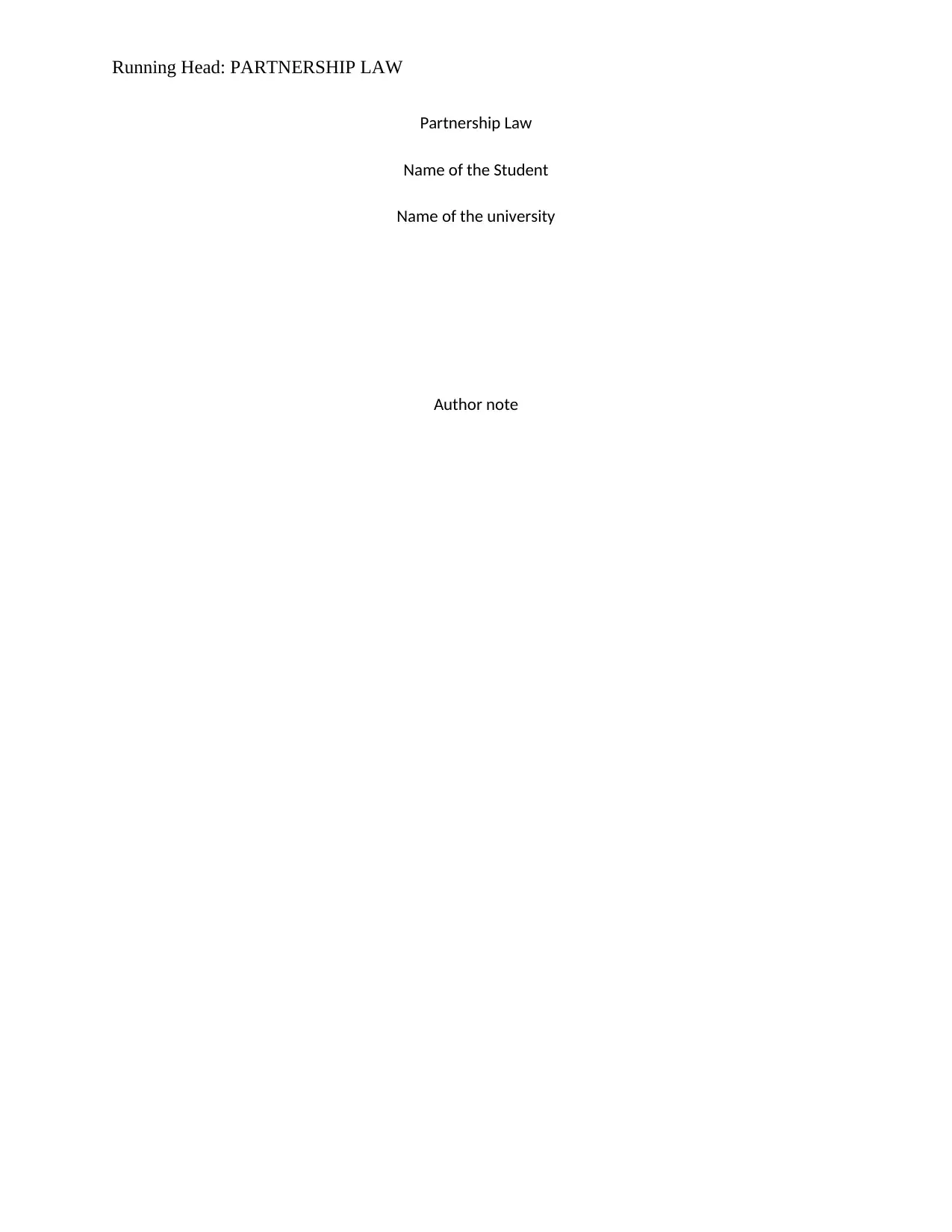
Running Head: PARTNERSHIP LAW
Partnership Law
Name of the Student
Name of the university
Author note
Partnership Law
Name of the Student
Name of the university
Author note
Paraphrase This Document
Need a fresh take? Get an instant paraphrase of this document with our AI Paraphraser
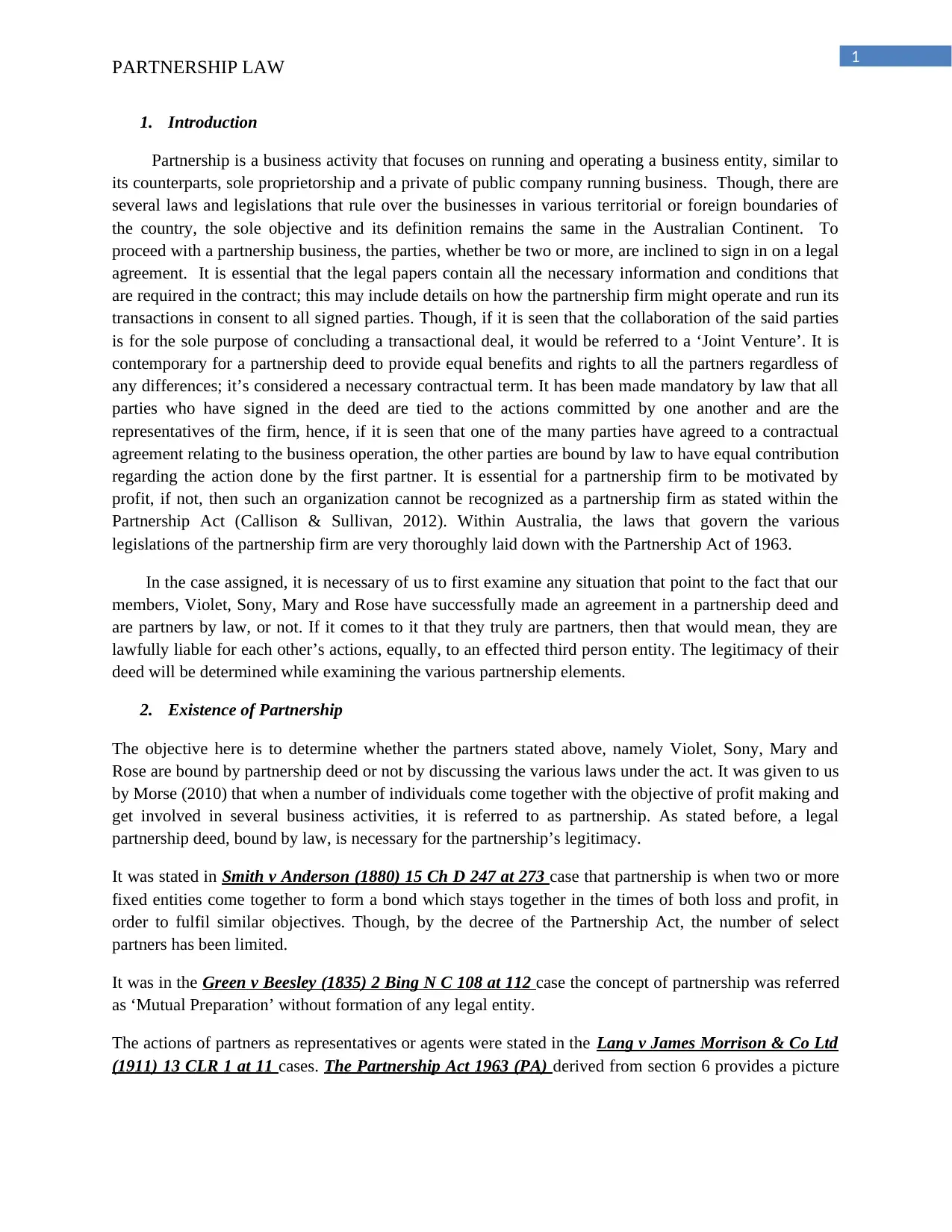
1
PARTNERSHIP LAW
1. Introduction
Partnership is a business activity that focuses on running and operating a business entity, similar to
its counterparts, sole proprietorship and a private of public company running business. Though, there are
several laws and legislations that rule over the businesses in various territorial or foreign boundaries of
the country, the sole objective and its definition remains the same in the Australian Continent. To
proceed with a partnership business, the parties, whether be two or more, are inclined to sign in on a legal
agreement. It is essential that the legal papers contain all the necessary information and conditions that
are required in the contract; this may include details on how the partnership firm might operate and run its
transactions in consent to all signed parties. Though, if it is seen that the collaboration of the said parties
is for the sole purpose of concluding a transactional deal, it would be referred to a ‘Joint Venture’. It is
contemporary for a partnership deed to provide equal benefits and rights to all the partners regardless of
any differences; it’s considered a necessary contractual term. It has been made mandatory by law that all
parties who have signed in the deed are tied to the actions committed by one another and are the
representatives of the firm, hence, if it is seen that one of the many parties have agreed to a contractual
agreement relating to the business operation, the other parties are bound by law to have equal contribution
regarding the action done by the first partner. It is essential for a partnership firm to be motivated by
profit, if not, then such an organization cannot be recognized as a partnership firm as stated within the
Partnership Act (Callison & Sullivan, 2012). Within Australia, the laws that govern the various
legislations of the partnership firm are very thoroughly laid down with the Partnership Act of 1963.
In the case assigned, it is necessary of us to first examine any situation that point to the fact that our
members, Violet, Sony, Mary and Rose have successfully made an agreement in a partnership deed and
are partners by law, or not. If it comes to it that they truly are partners, then that would mean, they are
lawfully liable for each other’s actions, equally, to an effected third person entity. The legitimacy of their
deed will be determined while examining the various partnership elements.
2. Existence of Partnership
The objective here is to determine whether the partners stated above, namely Violet, Sony, Mary and
Rose are bound by partnership deed or not by discussing the various laws under the act. It was given to us
by Morse (2010) that when a number of individuals come together with the objective of profit making and
get involved in several business activities, it is referred to as partnership. As stated before, a legal
partnership deed, bound by law, is necessary for the partnership’s legitimacy.
It was stated in Smith v Anderson (1880) 15 Ch D 247 at 273 case that partnership is when two or more
fixed entities come together to form a bond which stays together in the times of both loss and profit, in
order to fulfil similar objectives. Though, by the decree of the Partnership Act, the number of select
partners has been limited.
It was in the Green v Beesley (1835) 2 Bing N C 108 at 112 case the concept of partnership was referred
as ‘Mutual Preparation’ without formation of any legal entity.
The actions of partners as representatives or agents were stated in the Lang v James Morrison & Co Ltd
(1911) 13 CLR 1 at 11 cases. The Partnership Act 1963 (PA) derived from section 6 provides a picture
PARTNERSHIP LAW
1. Introduction
Partnership is a business activity that focuses on running and operating a business entity, similar to
its counterparts, sole proprietorship and a private of public company running business. Though, there are
several laws and legislations that rule over the businesses in various territorial or foreign boundaries of
the country, the sole objective and its definition remains the same in the Australian Continent. To
proceed with a partnership business, the parties, whether be two or more, are inclined to sign in on a legal
agreement. It is essential that the legal papers contain all the necessary information and conditions that
are required in the contract; this may include details on how the partnership firm might operate and run its
transactions in consent to all signed parties. Though, if it is seen that the collaboration of the said parties
is for the sole purpose of concluding a transactional deal, it would be referred to a ‘Joint Venture’. It is
contemporary for a partnership deed to provide equal benefits and rights to all the partners regardless of
any differences; it’s considered a necessary contractual term. It has been made mandatory by law that all
parties who have signed in the deed are tied to the actions committed by one another and are the
representatives of the firm, hence, if it is seen that one of the many parties have agreed to a contractual
agreement relating to the business operation, the other parties are bound by law to have equal contribution
regarding the action done by the first partner. It is essential for a partnership firm to be motivated by
profit, if not, then such an organization cannot be recognized as a partnership firm as stated within the
Partnership Act (Callison & Sullivan, 2012). Within Australia, the laws that govern the various
legislations of the partnership firm are very thoroughly laid down with the Partnership Act of 1963.
In the case assigned, it is necessary of us to first examine any situation that point to the fact that our
members, Violet, Sony, Mary and Rose have successfully made an agreement in a partnership deed and
are partners by law, or not. If it comes to it that they truly are partners, then that would mean, they are
lawfully liable for each other’s actions, equally, to an effected third person entity. The legitimacy of their
deed will be determined while examining the various partnership elements.
2. Existence of Partnership
The objective here is to determine whether the partners stated above, namely Violet, Sony, Mary and
Rose are bound by partnership deed or not by discussing the various laws under the act. It was given to us
by Morse (2010) that when a number of individuals come together with the objective of profit making and
get involved in several business activities, it is referred to as partnership. As stated before, a legal
partnership deed, bound by law, is necessary for the partnership’s legitimacy.
It was stated in Smith v Anderson (1880) 15 Ch D 247 at 273 case that partnership is when two or more
fixed entities come together to form a bond which stays together in the times of both loss and profit, in
order to fulfil similar objectives. Though, by the decree of the Partnership Act, the number of select
partners has been limited.
It was in the Green v Beesley (1835) 2 Bing N C 108 at 112 case the concept of partnership was referred
as ‘Mutual Preparation’ without formation of any legal entity.
The actions of partners as representatives or agents were stated in the Lang v James Morrison & Co Ltd
(1911) 13 CLR 1 at 11 cases. The Partnership Act 1963 (PA) derived from section 6 provides a picture
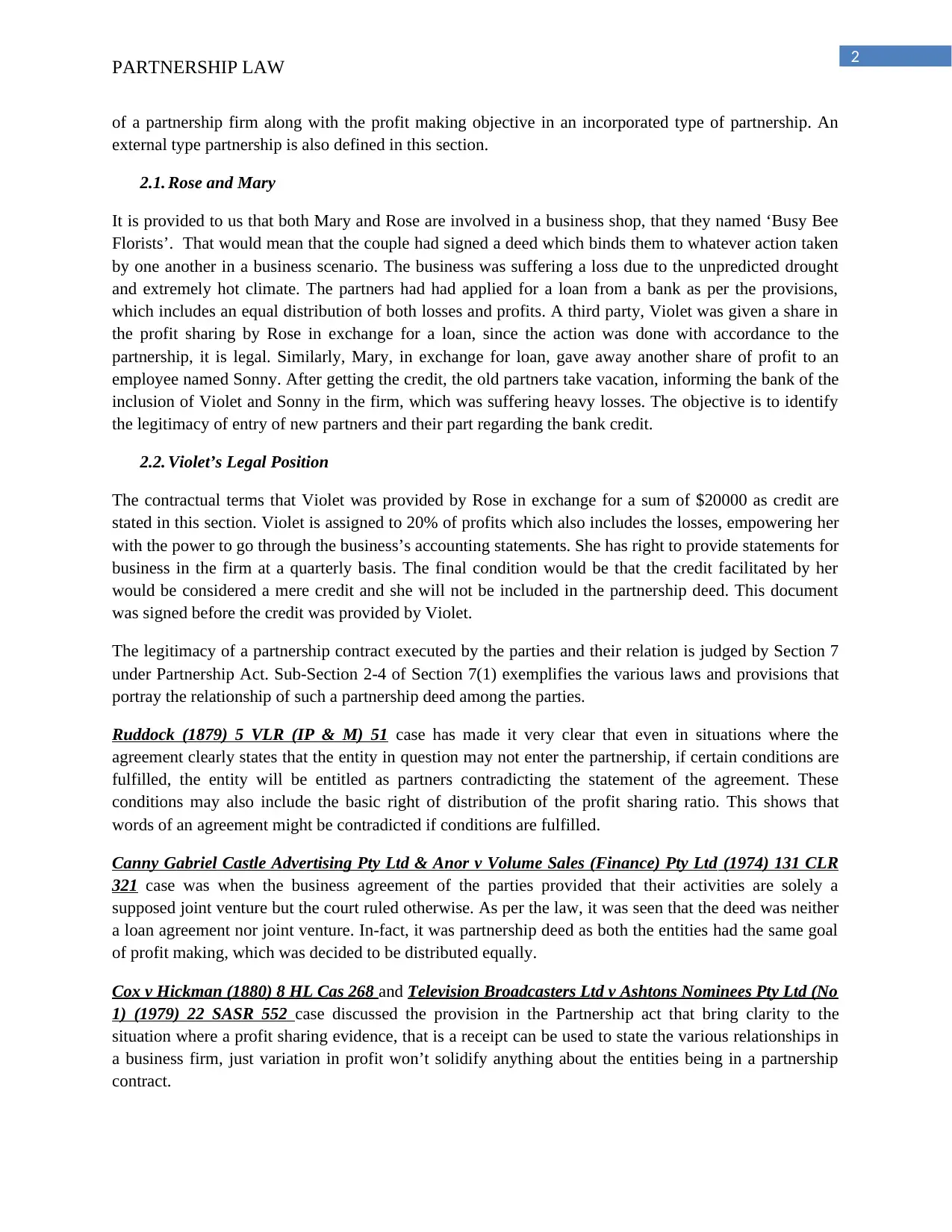
2
PARTNERSHIP LAW
of a partnership firm along with the profit making objective in an incorporated type of partnership. An
external type partnership is also defined in this section.
2.1. Rose and Mary
It is provided to us that both Mary and Rose are involved in a business shop, that they named ‘Busy Bee
Florists’. That would mean that the couple had signed a deed which binds them to whatever action taken
by one another in a business scenario. The business was suffering a loss due to the unpredicted drought
and extremely hot climate. The partners had had applied for a loan from a bank as per the provisions,
which includes an equal distribution of both losses and profits. A third party, Violet was given a share in
the profit sharing by Rose in exchange for a loan, since the action was done with accordance to the
partnership, it is legal. Similarly, Mary, in exchange for loan, gave away another share of profit to an
employee named Sonny. After getting the credit, the old partners take vacation, informing the bank of the
inclusion of Violet and Sonny in the firm, which was suffering heavy losses. The objective is to identify
the legitimacy of entry of new partners and their part regarding the bank credit.
2.2. Violet’s Legal Position
The contractual terms that Violet was provided by Rose in exchange for a sum of $20000 as credit are
stated in this section. Violet is assigned to 20% of profits which also includes the losses, empowering her
with the power to go through the business’s accounting statements. She has right to provide statements for
business in the firm at a quarterly basis. The final condition would be that the credit facilitated by her
would be considered a mere credit and she will not be included in the partnership deed. This document
was signed before the credit was provided by Violet.
The legitimacy of a partnership contract executed by the parties and their relation is judged by Section 7
under Partnership Act. Sub-Section 2-4 of Section 7(1) exemplifies the various laws and provisions that
portray the relationship of such a partnership deed among the parties.
Ruddock (1879) 5 VLR (IP & M) 51 case has made it very clear that even in situations where the
agreement clearly states that the entity in question may not enter the partnership, if certain conditions are
fulfilled, the entity will be entitled as partners contradicting the statement of the agreement. These
conditions may also include the basic right of distribution of the profit sharing ratio. This shows that
words of an agreement might be contradicted if conditions are fulfilled.
Canny Gabriel Castle Advertising Pty Ltd & Anor v Volume Sales (Finance) Pty Ltd (1974) 131 CLR
321 case was when the business agreement of the parties provided that their activities are solely a
supposed joint venture but the court ruled otherwise. As per the law, it was seen that the deed was neither
a loan agreement nor joint venture. In-fact, it was partnership deed as both the entities had the same goal
of profit making, which was decided to be distributed equally.
Cox v Hickman (1880) 8 HL Cas 268 and Television Broadcasters Ltd v Ashtons Nominees Pty Ltd (No
1) (1979) 22 SASR 552 case discussed the provision in the Partnership act that bring clarity to the
situation where a profit sharing evidence, that is a receipt can be used to state the various relationships in
a business firm, just variation in profit won’t solidify anything about the entities being in a partnership
contract.
PARTNERSHIP LAW
of a partnership firm along with the profit making objective in an incorporated type of partnership. An
external type partnership is also defined in this section.
2.1. Rose and Mary
It is provided to us that both Mary and Rose are involved in a business shop, that they named ‘Busy Bee
Florists’. That would mean that the couple had signed a deed which binds them to whatever action taken
by one another in a business scenario. The business was suffering a loss due to the unpredicted drought
and extremely hot climate. The partners had had applied for a loan from a bank as per the provisions,
which includes an equal distribution of both losses and profits. A third party, Violet was given a share in
the profit sharing by Rose in exchange for a loan, since the action was done with accordance to the
partnership, it is legal. Similarly, Mary, in exchange for loan, gave away another share of profit to an
employee named Sonny. After getting the credit, the old partners take vacation, informing the bank of the
inclusion of Violet and Sonny in the firm, which was suffering heavy losses. The objective is to identify
the legitimacy of entry of new partners and their part regarding the bank credit.
2.2. Violet’s Legal Position
The contractual terms that Violet was provided by Rose in exchange for a sum of $20000 as credit are
stated in this section. Violet is assigned to 20% of profits which also includes the losses, empowering her
with the power to go through the business’s accounting statements. She has right to provide statements for
business in the firm at a quarterly basis. The final condition would be that the credit facilitated by her
would be considered a mere credit and she will not be included in the partnership deed. This document
was signed before the credit was provided by Violet.
The legitimacy of a partnership contract executed by the parties and their relation is judged by Section 7
under Partnership Act. Sub-Section 2-4 of Section 7(1) exemplifies the various laws and provisions that
portray the relationship of such a partnership deed among the parties.
Ruddock (1879) 5 VLR (IP & M) 51 case has made it very clear that even in situations where the
agreement clearly states that the entity in question may not enter the partnership, if certain conditions are
fulfilled, the entity will be entitled as partners contradicting the statement of the agreement. These
conditions may also include the basic right of distribution of the profit sharing ratio. This shows that
words of an agreement might be contradicted if conditions are fulfilled.
Canny Gabriel Castle Advertising Pty Ltd & Anor v Volume Sales (Finance) Pty Ltd (1974) 131 CLR
321 case was when the business agreement of the parties provided that their activities are solely a
supposed joint venture but the court ruled otherwise. As per the law, it was seen that the deed was neither
a loan agreement nor joint venture. In-fact, it was partnership deed as both the entities had the same goal
of profit making, which was decided to be distributed equally.
Cox v Hickman (1880) 8 HL Cas 268 and Television Broadcasters Ltd v Ashtons Nominees Pty Ltd (No
1) (1979) 22 SASR 552 case discussed the provision in the Partnership act that bring clarity to the
situation where a profit sharing evidence, that is a receipt can be used to state the various relationships in
a business firm, just variation in profit won’t solidify anything about the entities being in a partnership
contract.
⊘ This is a preview!⊘
Do you want full access?
Subscribe today to unlock all pages.

Trusted by 1+ million students worldwide
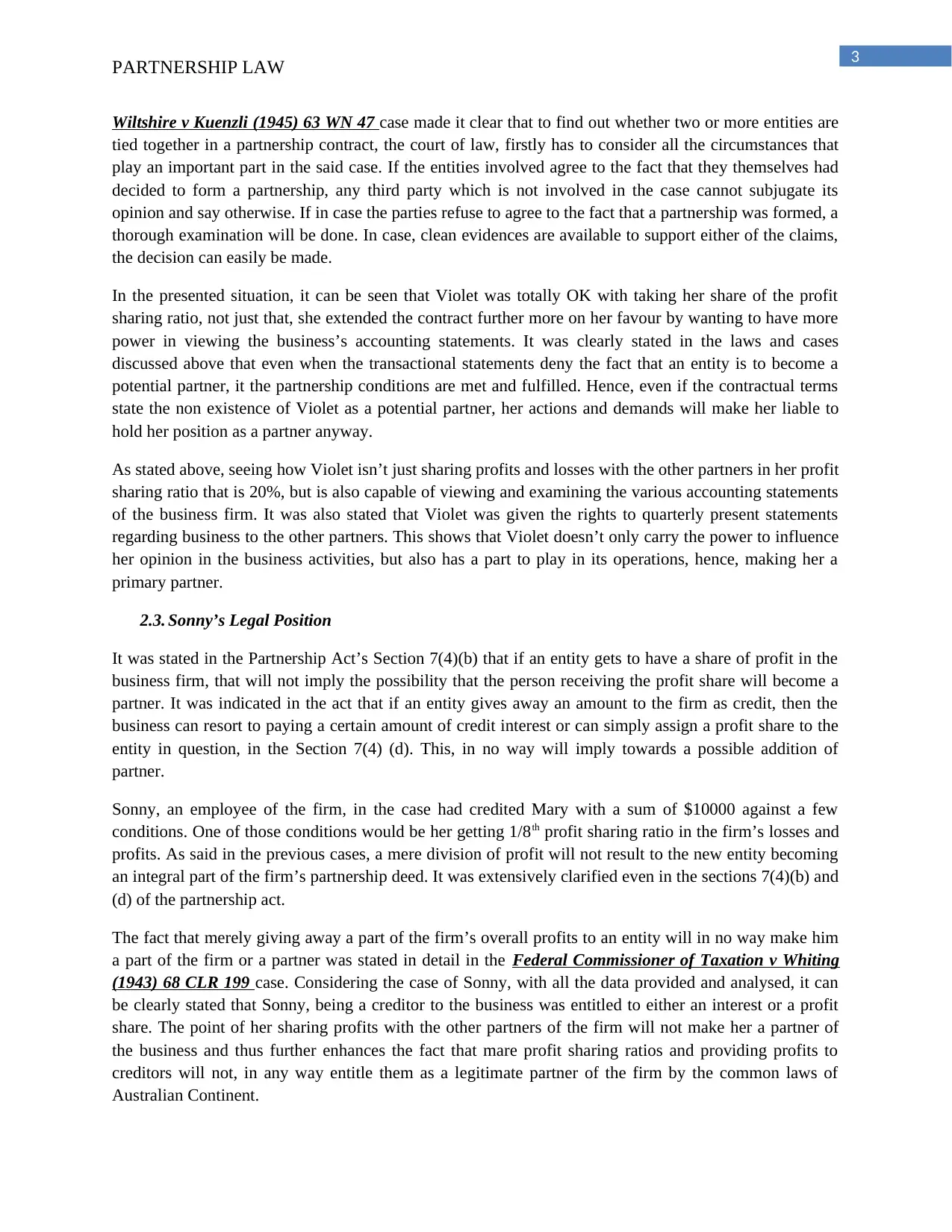
3
PARTNERSHIP LAW
Wiltshire v Kuenzli (1945) 63 WN 47 case made it clear that to find out whether two or more entities are
tied together in a partnership contract, the court of law, firstly has to consider all the circumstances that
play an important part in the said case. If the entities involved agree to the fact that they themselves had
decided to form a partnership, any third party which is not involved in the case cannot subjugate its
opinion and say otherwise. If in case the parties refuse to agree to the fact that a partnership was formed, a
thorough examination will be done. In case, clean evidences are available to support either of the claims,
the decision can easily be made.
In the presented situation, it can be seen that Violet was totally OK with taking her share of the profit
sharing ratio, not just that, she extended the contract further more on her favour by wanting to have more
power in viewing the business’s accounting statements. It was clearly stated in the laws and cases
discussed above that even when the transactional statements deny the fact that an entity is to become a
potential partner, it the partnership conditions are met and fulfilled. Hence, even if the contractual terms
state the non existence of Violet as a potential partner, her actions and demands will make her liable to
hold her position as a partner anyway.
As stated above, seeing how Violet isn’t just sharing profits and losses with the other partners in her profit
sharing ratio that is 20%, but is also capable of viewing and examining the various accounting statements
of the business firm. It was also stated that Violet was given the rights to quarterly present statements
regarding business to the other partners. This shows that Violet doesn’t only carry the power to influence
her opinion in the business activities, but also has a part to play in its operations, hence, making her a
primary partner.
2.3. Sonny’s Legal Position
It was stated in the Partnership Act’s Section 7(4)(b) that if an entity gets to have a share of profit in the
business firm, that will not imply the possibility that the person receiving the profit share will become a
partner. It was indicated in the act that if an entity gives away an amount to the firm as credit, then the
business can resort to paying a certain amount of credit interest or can simply assign a profit share to the
entity in question, in the Section 7(4) (d). This, in no way will imply towards a possible addition of
partner.
Sonny, an employee of the firm, in the case had credited Mary with a sum of $10000 against a few
conditions. One of those conditions would be her getting 1/8th profit sharing ratio in the firm’s losses and
profits. As said in the previous cases, a mere division of profit will not result to the new entity becoming
an integral part of the firm’s partnership deed. It was extensively clarified even in the sections 7(4)(b) and
(d) of the partnership act.
The fact that merely giving away a part of the firm’s overall profits to an entity will in no way make him
a part of the firm or a partner was stated in detail in the Federal Commissioner of Taxation v Whiting
(1943) 68 CLR 199 case. Considering the case of Sonny, with all the data provided and analysed, it can
be clearly stated that Sonny, being a creditor to the business was entitled to either an interest or a profit
share. The point of her sharing profits with the other partners of the firm will not make her a partner of
the business and thus further enhances the fact that mare profit sharing ratios and providing profits to
creditors will not, in any way entitle them as a legitimate partner of the firm by the common laws of
Australian Continent.
PARTNERSHIP LAW
Wiltshire v Kuenzli (1945) 63 WN 47 case made it clear that to find out whether two or more entities are
tied together in a partnership contract, the court of law, firstly has to consider all the circumstances that
play an important part in the said case. If the entities involved agree to the fact that they themselves had
decided to form a partnership, any third party which is not involved in the case cannot subjugate its
opinion and say otherwise. If in case the parties refuse to agree to the fact that a partnership was formed, a
thorough examination will be done. In case, clean evidences are available to support either of the claims,
the decision can easily be made.
In the presented situation, it can be seen that Violet was totally OK with taking her share of the profit
sharing ratio, not just that, she extended the contract further more on her favour by wanting to have more
power in viewing the business’s accounting statements. It was clearly stated in the laws and cases
discussed above that even when the transactional statements deny the fact that an entity is to become a
potential partner, it the partnership conditions are met and fulfilled. Hence, even if the contractual terms
state the non existence of Violet as a potential partner, her actions and demands will make her liable to
hold her position as a partner anyway.
As stated above, seeing how Violet isn’t just sharing profits and losses with the other partners in her profit
sharing ratio that is 20%, but is also capable of viewing and examining the various accounting statements
of the business firm. It was also stated that Violet was given the rights to quarterly present statements
regarding business to the other partners. This shows that Violet doesn’t only carry the power to influence
her opinion in the business activities, but also has a part to play in its operations, hence, making her a
primary partner.
2.3. Sonny’s Legal Position
It was stated in the Partnership Act’s Section 7(4)(b) that if an entity gets to have a share of profit in the
business firm, that will not imply the possibility that the person receiving the profit share will become a
partner. It was indicated in the act that if an entity gives away an amount to the firm as credit, then the
business can resort to paying a certain amount of credit interest or can simply assign a profit share to the
entity in question, in the Section 7(4) (d). This, in no way will imply towards a possible addition of
partner.
Sonny, an employee of the firm, in the case had credited Mary with a sum of $10000 against a few
conditions. One of those conditions would be her getting 1/8th profit sharing ratio in the firm’s losses and
profits. As said in the previous cases, a mere division of profit will not result to the new entity becoming
an integral part of the firm’s partnership deed. It was extensively clarified even in the sections 7(4)(b) and
(d) of the partnership act.
The fact that merely giving away a part of the firm’s overall profits to an entity will in no way make him
a part of the firm or a partner was stated in detail in the Federal Commissioner of Taxation v Whiting
(1943) 68 CLR 199 case. Considering the case of Sonny, with all the data provided and analysed, it can
be clearly stated that Sonny, being a creditor to the business was entitled to either an interest or a profit
share. The point of her sharing profits with the other partners of the firm will not make her a partner of
the business and thus further enhances the fact that mare profit sharing ratios and providing profits to
creditors will not, in any way entitle them as a legitimate partner of the firm by the common laws of
Australian Continent.
Paraphrase This Document
Need a fresh take? Get an instant paraphrase of this document with our AI Paraphraser
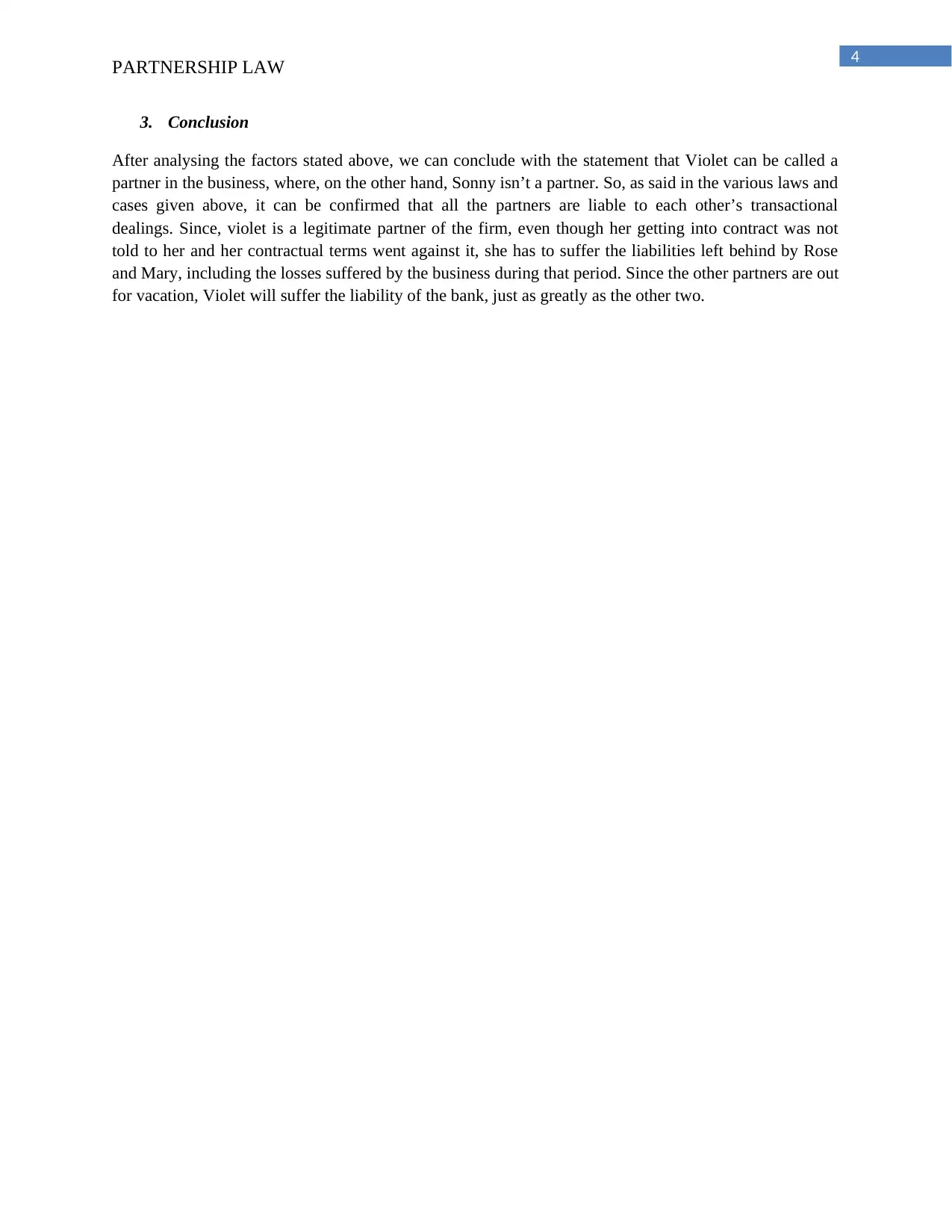
4
PARTNERSHIP LAW
3. Conclusion
After analysing the factors stated above, we can conclude with the statement that Violet can be called a
partner in the business, where, on the other hand, Sonny isn’t a partner. So, as said in the various laws and
cases given above, it can be confirmed that all the partners are liable to each other’s transactional
dealings. Since, violet is a legitimate partner of the firm, even though her getting into contract was not
told to her and her contractual terms went against it, she has to suffer the liabilities left behind by Rose
and Mary, including the losses suffered by the business during that period. Since the other partners are out
for vacation, Violet will suffer the liability of the bank, just as greatly as the other two.
PARTNERSHIP LAW
3. Conclusion
After analysing the factors stated above, we can conclude with the statement that Violet can be called a
partner in the business, where, on the other hand, Sonny isn’t a partner. So, as said in the various laws and
cases given above, it can be confirmed that all the partners are liable to each other’s transactional
dealings. Since, violet is a legitimate partner of the firm, even though her getting into contract was not
told to her and her contractual terms went against it, she has to suffer the liabilities left behind by Rose
and Mary, including the losses suffered by the business during that period. Since the other partners are out
for vacation, Violet will suffer the liability of the bank, just as greatly as the other two.
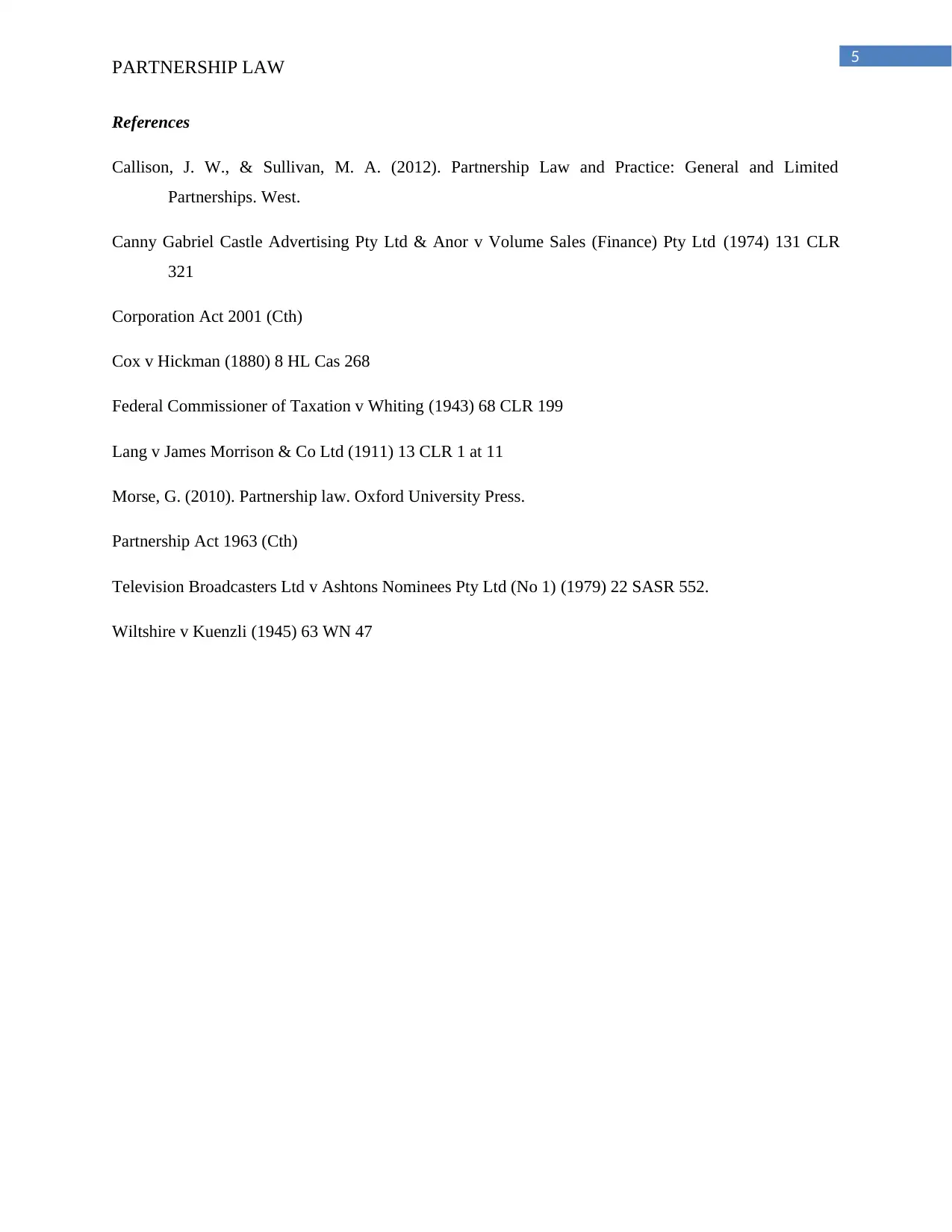
5
PARTNERSHIP LAW
References
Callison, J. W., & Sullivan, M. A. (2012). Partnership Law and Practice: General and Limited
Partnerships. West.
Canny Gabriel Castle Advertising Pty Ltd & Anor v Volume Sales (Finance) Pty Ltd (1974) 131 CLR
321
Corporation Act 2001 (Cth)
Cox v Hickman (1880) 8 HL Cas 268
Federal Commissioner of Taxation v Whiting (1943) 68 CLR 199
Lang v James Morrison & Co Ltd (1911) 13 CLR 1 at 11
Morse, G. (2010). Partnership law. Oxford University Press.
Partnership Act 1963 (Cth)
Television Broadcasters Ltd v Ashtons Nominees Pty Ltd (No 1) (1979) 22 SASR 552.
Wiltshire v Kuenzli (1945) 63 WN 47
PARTNERSHIP LAW
References
Callison, J. W., & Sullivan, M. A. (2012). Partnership Law and Practice: General and Limited
Partnerships. West.
Canny Gabriel Castle Advertising Pty Ltd & Anor v Volume Sales (Finance) Pty Ltd (1974) 131 CLR
321
Corporation Act 2001 (Cth)
Cox v Hickman (1880) 8 HL Cas 268
Federal Commissioner of Taxation v Whiting (1943) 68 CLR 199
Lang v James Morrison & Co Ltd (1911) 13 CLR 1 at 11
Morse, G. (2010). Partnership law. Oxford University Press.
Partnership Act 1963 (Cth)
Television Broadcasters Ltd v Ashtons Nominees Pty Ltd (No 1) (1979) 22 SASR 552.
Wiltshire v Kuenzli (1945) 63 WN 47
⊘ This is a preview!⊘
Do you want full access?
Subscribe today to unlock all pages.

Trusted by 1+ million students worldwide
1 out of 6
Related Documents
Your All-in-One AI-Powered Toolkit for Academic Success.
+13062052269
info@desklib.com
Available 24*7 on WhatsApp / Email
![[object Object]](/_next/static/media/star-bottom.7253800d.svg)
Unlock your academic potential
Copyright © 2020–2025 A2Z Services. All Rights Reserved. Developed and managed by ZUCOL.





